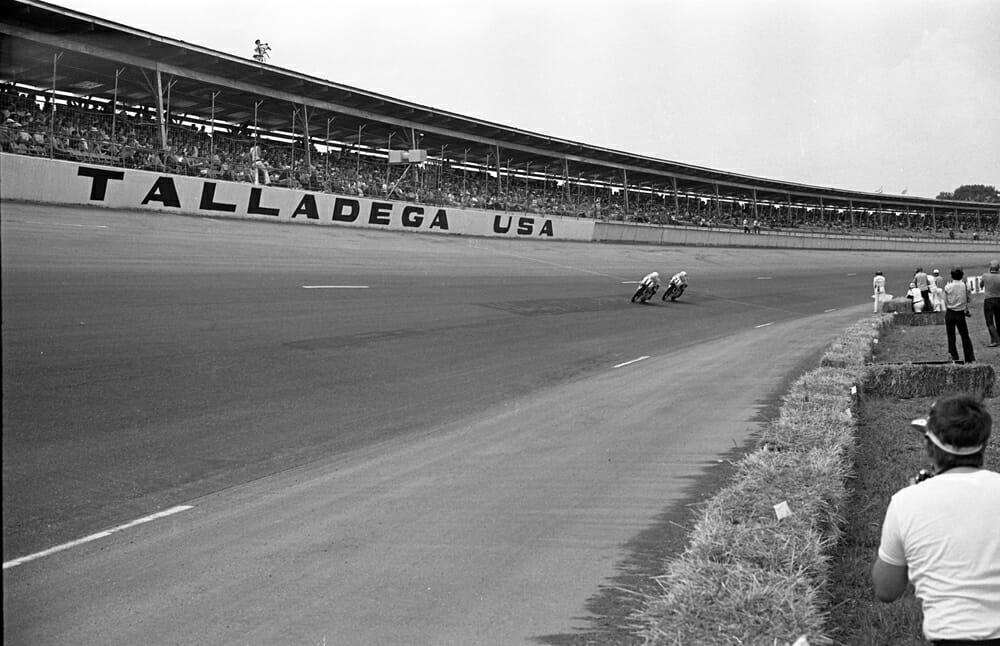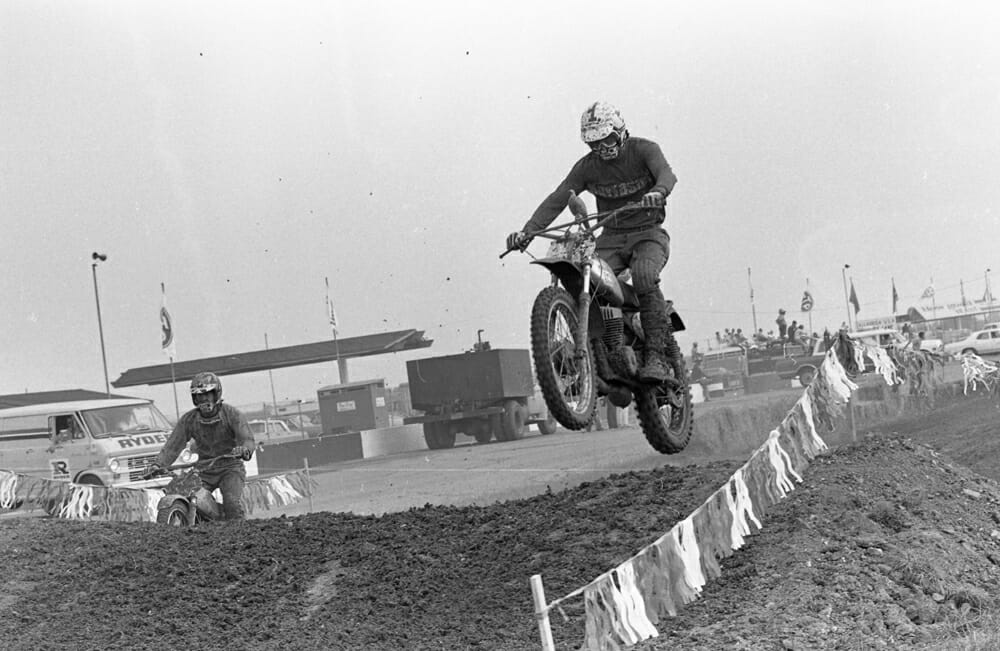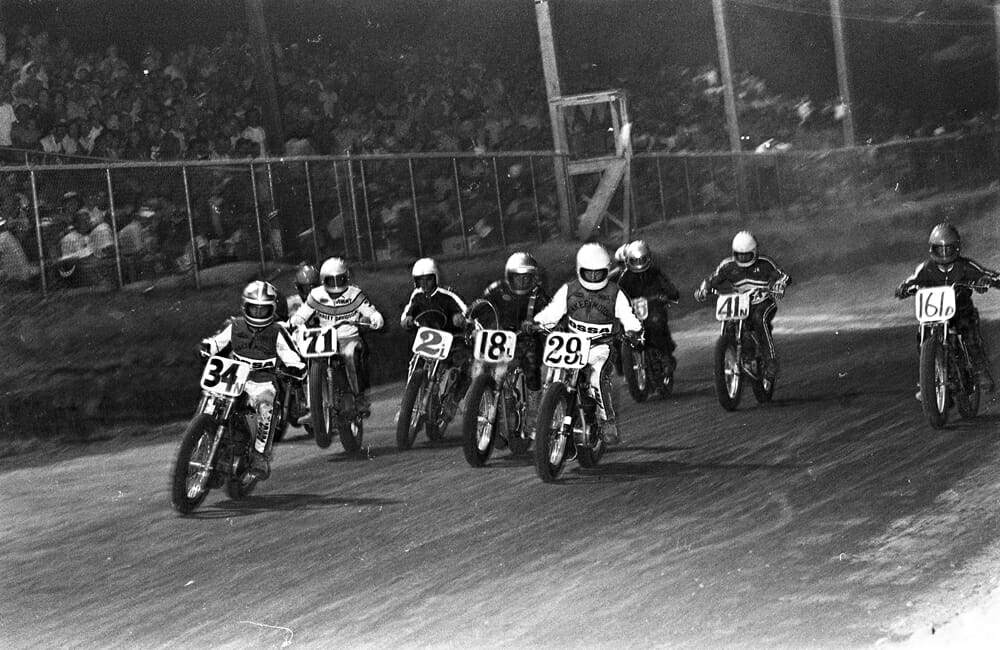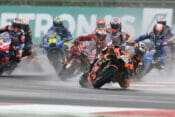Cycle News Archives
COLUMN
When Talladega Had Its Own Bike Week
With this year’s Daytona’s Bike Week now in our rearview mirror, it’s a good time to look back when another NASCAR track, Talladega Superspeedway, hosted its own mini version of Bike Week. At its height in the early 1970s, the Talladega weekend featured national road racing on the track’s high banks, complete with a national radio broadcast (the MRN Network) of the race, AMA Motocross Nationals on a temporary infield track and flat track racing on a short track across the street from the big speedway. The event attracted motorcycle racing fans from across the southeast and, one year, a motorcycle gang brought chaos to the Alabama facility.

In the late 1960s NASCAR and Daytona International Speedway founder Bill France was looking to build another Super Speedway. This time he wanted to go even bigger and faster than Daytona. He searched for a suitable location across the southeast before finally landing on Talladega on the site of an old airfield. France broke ground on the new track in the spring of 1968. The still unfinished track opened a year later at a cost of $4 million. The track was named Alabama International Motor Speedway. The name would remain for twenty years, all through the motorcycle racing years, until 1989, when the facility’s name was changed to Talladega Superspeedway.
According to ex-racer and World Superbike founder Steve McLaughlin, “Big Bill” France added the infield road course specifically to host motorcycle races. “Big Bill stepped in to help expand the AMA road racing schedule,” McLaughlin explained. Had it not been for the addition of Talladega, road races on the 1970 AMA Grand National Championship calendar would have been down to just three events—Daytona, Loudon and Seattle.
Talladega’s motorcycle course was like Daytona in that it combined the NASCAR oval and an infield road course section. But riders who raced there report the banking was steeper (31° vs 33°) than Daytona, the banked oval even more broad and the infield flowed better and featured elevation changes. It would become the fastest racecourse on the AMA national circuit.

At the first AMA Grand National at Talladega in May of 1970, qualifying was done by way of a flying lap around the NASCAR oval. Gene Romero won the pole with a lap at 156.521 mph on his factory Triumph Trident. The big surprise in the national main event was rookie David Aldana taking the victory on his factory BSA Triple. Aldana was an undeniable talent and fans and fellow racers knew he’d be a winner, but few expected him to score his first national win on a road course. Even Aldana admitted to being very green in terms of road racing experience at that point.
Talking about the win, Aldana says BSA had some very special parts from the British factory.
“I had the fastest bike on the track,” Aldana said. “The British bikes at Daytona went back to the UK. My trick stuff went undetected because of my 12th-place finish at Daytona. I was still learning from riders around me during Talladega.”
Aldana won $7860 purse money for his win and a $5000 bonus from BSA, making his payday the equivalent of almost $100,000 in today’s dollars! His race average of 104.589 mph made it the fastest national in AMA history to that point.
Talladega’s motorcycle course was like Daytona in that it combined the NASCAR oval and an infield road course section.
The long stretches at full throttle always took a toll on the bikes at Talladega. Less than half the starters went the distance in that inaugural motorcycle race.
The first Talladega event was successful enough, with 13,000 fans, that the race was moved to the Labor Day weekend for 1971. It would run on that date through 1974. The race was promoted and run by the same folks that ran Daytona, and after moving the date, the Talladega AMA event was the final promotion of the season for the Daytona personnel and the parties on Sunday night after the race became legendary.
Heat and humidity greeted riders and fans at the 1971 race. It was another first-time AMA Grand National winner in Yvon DuHamel on a Kawasaki. And unlike Aldana, who won a national road race before anyone thought he would, it was the exact opposite for DuHamel who everyone expected to win a road race national years earlier. Many times, since he came on the scene in the late ‘60s, DuHamel had been the fastest rider and led many races, but mechanical issues, crashes and every other problem a racer could face, kept the popular Canadian off the top of the podium until Talladega. It was worth the wait though since Kawasaki paid DuHamel a $10,000 bonus for giving the company its first Grand National victory. DuHamel’s win was helped by blazingly fast pit stops. His first stop took just four seconds, aided by the dry-break refueling system and a quick crew directed by team manager Bob Hansen.
Attendance increased to 15,000 in ’71 despite the oppressive heat.
A big issue that year was the Outlaw motorcycle gang showed up at the track’s campgrounds at night and began stealing motorcycles, sometimes at gunpoint. Alabama State Troopers and sheriff’s deputies showed up in force and arrested 200 gang members.
Cliff Cook was one of those campers and remembers the Outlaw gang incident. He said law enforcement suddenly showed up in huge numbers and were lined up around the campground rifles aimed.
“They were accustomed to putting down civil unrest in the day and absolutely took control,” Cook said. “When finished they had a pile of firearms and a pile of drugs. Also, they used school buses to haul the Outlaws off to jail and nobody was using the word ‘pig’ to criticize them.”
DuHamel came back and won again in 1972 in front of 18,000 fans, this time lapping the entire field except for Kawasaki teammate Gary Nixon. With purse and contingencies DuHamel took home $18,300 (over $122,000 in today’s dollars), the biggest purse the race would ever see.
An AMA Motocross National was also held on the weekend, ala Daytona Supercross, in 1972 and ’73, adding to the fan appeal. In ’72 the winners were Gary Bailey (250cc) and Brad Lackey (500cc). In ’73 it was Gary Jones (250cc) and Pierre Karsmakers (500cc). A big flat track regional was also held on the short track next door and drew many of the top flat track riders. In ’76 the race was an AMA Grand National Short Track event and was won by rookie Terry Poovey. It marked Poovey’s first Grand National victory.
For the 1973 race, a chicane was added to the back straight to slow the bikes down. The big 750 Kawasakis and Suzukis had blazing top end (with 170 mph-plus trap speeds), but they all faltered in the race, and it was Kel Carruthers on a Yamaha TZ350 taking the victory and leading a Yamaha sweep with Steve Baker and Gary Fisher rounding out the podium finishers. Almost unbelievably, Carruthers was not only racing, but was Yamaha’s racing manager and was wrenching on the team bikes throughout weekend.
The final AMA Grand National Road Race held at Talladega was in 1974. Kenny Roberts took the victory in the race that was shortened from 200 miles to 75, which meant no pit stops. Barry Sheene raced in the ’74 event and finished fourth on a Suzuki. For some reason crowds quicky declined in 1974, so the race was off the calendar in 1975.

AMA Superbike races returned to the track for four years from 1980 to 1983 and except for the 1980 race, were held the weekend after Daytona. Eddie Lawson won the revival of Talladega in 1980 on his factory Kawasaki Superbike. In ’81 it was Freddie Spencer on a factory Honda, Lawson and Kawasaki again in ’83 and Mike Baldwin closing out the Superbike era at the track in ’84 with a victory on his factory Honda. While the race returned the crowds didn’t, and the event was again shelved for several years.
The history of national motorcycle racing at the circuit came to a close in 1988 and ’89 when the track hosted a Pro-Am-type weekend that featured just the AMA 600cc and 750cc Supersport races, as well as AMA National Endurance events. By then the infield section of the track was neglected and crumbling. Michael Barnes reported that “your bike’s paint and your knuckles suffered from the rocks.”
Tommy Lynch, who won the AMA 750cc Supersport race in the final AMA event recalled the 1989 event.
“I remember it seemed like Daytona on steroids to me,” he said. “Very fun infield with lots of character. It was pretty narrow in spots with a few small elevation changes. There was a really fun banked right hander that was probably my favorite corner. We loaded my Yoshimura bike in Cary Andrew’s Hypercycle van and made the trek from California to Alabama. Without Cary taking me and being my mechanic, none of it would have been possible. So huge thanks to him for probably my biggest road race win. The 1989 750 Supersport Series was stacked with talent. This was my first and last trip to Talladega. Sweet memories.” CN
Click here to read the Archives Column in the Cycle News Digital Edition Magazine.
Subscribe to nearly 50 years of Cycle News Archive issues
